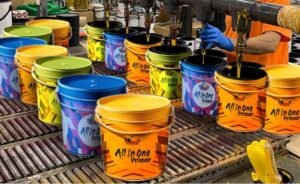Introduction to Raw Materials
Mithila Paints has established itself as a prominent player in the paint manufacturing industry, renowned for its dedication to quality and innovation. Founded several decades ago, the company has steadily grown from a small local establishment to a reputable brand recognized across the region. Mithila Paints was born out of the necessity to meet the demand for high-quality paints that offer durability, aesthetic appeal, and environmentally friendly options for consumers.
The mission of Mithila Paints revolves around two core principles: providing superior products and ensuring sustainability. The company believes in manufacturing paints that not only enhance the beauty of spaces but also contribute positively to the environment. One of the pivotal commitments of Mithila Paints is the continuous improvement of the manufacturing process through the utilization of advanced technologies and the finest raw materials available in the market.
Mithila Paints understands that the foundation of any high-quality paint lies in its ingredients. Therefore, the selection and sourcing of raw materials are conducted with meticulous attention. The company prioritizes materials that meet stringent quality standards, which helps in producing paints that are not only visually stimulating but also resilient against various environmental conditions. By focusing on these aspects, Mithila Paints has built a reputation for excellence that extends beyond mere functionality, emphasizing design and sustainability.
This dedication further aligns with the broader industry movement towards eco-friendly solutions, acknowledging the increasing importance that consumers place on environmentally responsible products. Mithila Paints remains committed to sourcing raw materials responsibly, ensuring that their production processes reflect a balance between performance, safety, and ecological responsibility. This journey towards excellence positions Mithila Paints as a leader in the paint industry, setting a benchmark for quality and sustainability.
Importance of Raw Materials in Paint Production
Raw materials are fundamental to the paint manufacturing process, serving as the building blocks for the final product. Their quality and type play a pivotal role in determining various characteristics of the paint, including its durability, finish, and ease of application. In paint production, the selection of raw materials directly influences performance and customer satisfaction, making it essential for manufacturers like Mithila Paints to prioritize high-quality inputs.
The first major category of raw materials is binders, which provide adhesion and stability in paint formulations. Different binders, such as acrylics or alkyds, offer varying degrees of flexibility and weather resistance, impacting the paint’s overall performance. The right choice of binder can enhance the longevity of the paint, allowing it to withstand environmental stressors without deteriorating.
Another crucial category is pigments, which define the color and opacity of the paint. High-quality pigments contribute significantly to the vibrancy and consistency of color. Additionally, they can affect other attributes like covering power and UV resistance, which are essential for outdoor applications. The interplay between the type of pigment used and the specific binder determines the final product’s aesthetic appeal and functionality.
Additives also play an important role in optimizing paint performance. These substances influence aspects such as drying time, viscosity, and mildew resistance. By incorporating effective additives, manufacturers can enhance the usability and effectiveness of their products, ensuring they meet the diverse needs of consumers.
Overall, the careful selection of raw materials is vital to creating high-quality paint products that meet industry standards and customer expectations. Mithila Paints understands this importance and is committed to sourcing only the best raw materials, ensuring that their paints are durable, aesthetically pleasing, and effective for a variety of applications.

Key Raw Materials Used at Mithila Paints
Mithila Paints relies on several crucial raw materials in its paint manufacturing process. These essential components, such as pigments, binders, solvents, and additives, play a significant role in determining the quality, durability, and performance of the final products.
At the heart of any paint formulation are pigments, which impart color and opacity. They can be classified into two main categories: organic and inorganic pigments. Organic pigments are derived from carbon compounds and are known for their vivid colors and transparency. On the other hand, inorganic pigments offer excellent lightfastness, stability, and opacity, making them ideal for exterior applications where durability is crucial. These pigments are carefully selected to ensure that Mithila Paints can provide a diverse color palette that meets the varied needs of its customers.
Another primary component is binders, which are essential for ensuring adhesion and film formation. Binders act as a glue that holds the pigment particles and other components together, creating a coherent film upon drying. Different types of binders are used depending on the intended use of the paint, such as latex-based binders for water-based paints and alkyd or acrylic resin for solvent-based options. The choice of binder significantly impacts the paint’s finish, flexibility, and resistance to environmental factors.
Solvents are another key raw material that influences the application and drying of paints. They are responsible for dissolving the binders and adjusting the viscosity of the paint to ensure ease of application. Water is the primary solvent used in water-based paints, while organic solvents like mineral spirits may be employed in oil-based formulations. The selection of solvent affects not only application but also the overall safety and environmental impact of the paint.
Lastly, additives enhance various properties of the paint, such as performance, stability, and texture. These may include anti-foaming agents, thickeners, and preservatives, each of which contributes to the paint’s overall effectiveness. By utilizing a combination of these raw materials, Mithila Paints ensures that its products meet high standards in terms of quality, sustainability, and customer satisfaction.
Sourcing and Quality Control of Raw Materials
At Mithila Paints, the essential process of sourcing raw materials begins with a commitment to quality and sustainability. The company collaborates with reputable suppliers who share a similar vision for providing high-grade ingredients required for paint manufacturing. These partnerships are not merely transactional; they are built on trust, shared values, and a mutual dedication to excellence. By working closely with suppliers, Mithila Paints ensures that the raw materials, such as pigments, binders, solvents, and additives, meet rigorous industry standards and align with environmental regulations.
One of the key aspects of sourcing at Mithila Paints is the meticulous selection of suppliers. The procurement team conducts thorough assessments of potential partners, evaluating their production processes, quality certifications, and adherence to ethical sourcing practices. This diligence contributes to establishing long-term relationships with suppliers who are reliable and committed to continuous improvement. As a result, Mithila Paints has successfully built a robust supply chain that consistently delivers high-quality raw materials for paint production.
Equally important to the sourcing process is the implementation of stringent quality control measures. Mithila Paints employs a multi-tiered approach to ensure that every batch of raw materials is scrutinized before entering the production line. The quality control team conducts comprehensive testing for various parameters, including purity, viscosity, and compatibility with other components. This not only guarantees the safety and efficacy of the final paint products but also enhances the overall consistency and performance that customers have come to expect from the brand.
In conclusion, the sourcing and quality control practices at Mithila Paints reflect a dedication to providing superior paint products. By forging strong partnerships with reputable suppliers and establishing robust quality control protocols, the company ensures that every can of paint meets the highest standards of quality and reliability.

Innovative Raw Materials in Modern Paint Manufacturing
In recent years, the paint manufacturing industry has witnessed a significant transformation driven by the growing demand for eco-friendly and sustainable options. Mithila Paints is at the forefront of this shift, actively exploring and integrating innovative raw materials that align with environmental goals and modern consumer preferences. As sustainability becomes increasingly important to both manufacturers and consumers, the focus has turned towards creating paints with lower environmental impact, while maintaining high-performance standards.
One noteworthy trend is the use of bio-based raw materials, which are derived from renewable resources such as plants and agricultural waste. These materials not only reduce dependence on petroleum-based products but also help in minimizing carbon emissions throughout the production lifecycle. By incorporating bio-based solvents, resins, and additives, Mithila Paints enhances the ecological profile of its paint products, catering to environmentally conscious consumers.
Additionally, there has been a surge in the development of non-toxic pigments and colorants that help eliminate hazardous substances traditionally found in conventional paints. These innovative alternatives promote not only safety but also improved indoor air quality, a feature that is becoming a prerequisite for modern consumers. Mithila Paints is committed to ensuring that its product formulations are free from harmful volatile organic compounds (VOCs), thereby supporting healthier living spaces.
Moreover, sustainable practices extend to packaging, where innovative materials are being used to minimize waste and promote recyclability. It is imperative for the paint industry to embrace long-term sustainability strategies that encompass the entire production process, from raw material sourcing to delivery. Mithila Paints is taking strides in this direction, ensuring that its raw material choices reflect a commitment to sustainability while also meeting the evolving preferences of today’s consumers.
The Role of Technology in Raw Material Processing
In the context of modern paint manufacturing, the role of technology cannot be overstated. At Mithila Paints, the integration of advanced technological systems plays a pivotal role in the processing of raw materials, significantly enhancing efficiency and product quality. The adoption of automation in the production cycle minimizes human intervention, thus reducing the chances of errors and ensuring consistent performance. Automated systems facilitate the precise measurement and mixing of ingredients, which is crucial for maintaining the desired quality and characteristics of the paint.
Furthermore, precision formulation technologies have been embraced by Mithila Paints to ensure that each batch of paint meets stringent specifications. These technologies allow for the meticulous blending of pigments, binders, and additives, leading to superior color accuracy and finish. By utilizing software-driven formulations, the company can swiftly adjust ratios based on real-time data, optimizing the use of raw materials while minimizing waste.
Quality testing is another vital aspect of Mithila Paints’ commitment to excellence. The company employs advanced testing technologies that assess various parameters of raw materials, such as viscosity, pH levels, and pigment dispersion. These evaluations are critical to ensuring that only the highest quality raw materials are used in the final products. By maintaining stringent quality control measures, Mithila Paints safeguards its reputation for delivering reliable and high-performance coatings.
Additionally, the implementation of data analytics in raw material processing allows Mithila Paints to track production efficiency and product performance over time. This capability not only contributes to continuous improvement in manufacturing processes but also aids in anticipating and mitigating potential issues. As the industry evolves, Mithila Paints remains committed to leveraging technological innovations that enhance both the efficiency of raw material processing and the overall quality of its paint products.

Challenges in Raw Material Procurement
Raw material procurement is a critical aspect of paint manufacturing, and companies like Mithila Paints encounter a range of challenges in this area. One of the primary issues is supply chain disruptions, which can arise from natural disasters, geopolitical tensions, or logistical complications. These disruptions can lead to delays in receiving essential components such as pigments, solvents, and additives, consequently affecting production timelines and overall operations.
In addition to supply chain instability, price volatility is another significant challenge in sourcing raw materials. The prices for key ingredients in paint manufacturing can fluctuate due to various factors, including changes in demand, market speculation, and fluctuations in the cost of raw materials like crude oil, which directly impacts the cost of solvents and resins. Such price instability not only complicates budgeting and forecasting but can also squeeze profit margins, necessitating careful financial planning.
Moreover, global market trends play a significant role in the availability and cost of raw materials. Economic growth in emerging markets can drive up demand for paint products, subsequently impacting the supply of raw materials. Additionally, shifts in regulatory environments concerning the sustainability of certain materials can compel manufacturers to seek alternative raw materials that might not be as readily available or economically viable.
To mitigate these challenges, Mithila Paints employs several strategic approaches. By establishing strong relationships with diverse suppliers, the company can foster reliability and encourage better pricing arrangements. Moreover, continuously monitoring global market trends and adjusting procurement strategies allows for more informed decision-making regarding stock levels and sourcing options. Investment in sustainable practices and materials is also a growing focus, positioning Mithila Paints to adapt to emerging market demands more effectively.

Case Studies of Successful Paint Products
Mithila Paints has established itself as a prominent player in the paint manufacturing industry, owing much of its success to the meticulous selection of raw materials that directly influences the performance, durability, and appeal of its products. This section discusses notable case studies of specific paint products that have garnered recognition and popularity, demonstrating how raw materials played a pivotal role in their development.
One standout product, Mithila Paints Exterior Paint, utilizes a curated blend of environmentally-friendly pigments and high-performance resins. The selection of bio-based raw materials not only contributes to a reduced carbon footprint but also enhances the paint’s resistance to fading and degradation from harsh weather conditions. The strategic choice of these sustainable ingredients resonates well with environmentally conscious consumers, resulting in increased market demand and customer loyalty.
Another successful case is the Mithila paints Interior Paint, which was formulated using advanced acrylic emulsions and finely milled calcium carbonate. This combination not only improves coverage and application ease but also ensures a smooth finish that appeals to homeowners and professional painters alike. The choice of high-grade calcium carbonate, a raw material known for its superior hiding properties, markedly boosts the paint’s opacity and durability, making it a preferred product in residential and commercial projects.
Furthermore, the Luxe Gloss Enamel Paint stands out due to its premium resin system that incorporates specific additives for enhanced adhesion and gloss retention. The strategic sourcing of these raw materials ensures that the product withstands the rigors of daily wear and tear while maintaining a vibrant finish. Its popularity can be attributed to the depth of finish and long-lasting protection it offers, setting a benchmark in the market.
These case studies serve as a testament to the importance of raw materials in paint manufacturing, illuminating the profound impact they have on product success and consumer preference.

Conclusion and Future Trends in Raw Materials
As we have explored throughout this blog post, the use of raw materials in paint manufacturing is a critical aspect that determines the quality, performance, and environmental impact of the final product. Mithila Paints has demonstrated a profound understanding of these elements, emphasizing sustainability and innovation in their sourcing and formulation practices. The selection of raw materials not only influences the durability and application of paints but also addresses the growing consumer demand for eco-friendly and safe products.
The future of raw material usage in the paint industry is expected to pivot towards increased sustainability, with a growing focus on renewable resources and bio based alternatives. This shift is driven by evolving regulations and consumer preferences that favor paints with lower volatile organic compounds (VOCs) and reduced environmental footprints. Mithila Paints is poised to lead this transition, incorporating advanced technologies and sustainable practices in their manufacturing processes. Such innovations are likely to result in new, effective formulations that maintain high performance while minimizing ecological impact.
Furthermore, collaborations with research institutions and suppliers will play a crucial role in identifying and creating new raw materials that are both effective and environmentally friendly. Advances in material science may pave the way for the development of smarter paints, such as self-cleaning or thermal-regulating coatings, which will further enhance the functionality and appeal of paint products. By prioritizing innovation and sustainability, Mithila Paints is not only investing in the future of its products but also contributing positively to the wider industry standards and practices.
In summary, as the paint manufacturing landscape evolves, Mithila Paints remains committed to leveraging cutting-edge raw materials and sustainable approaches to meet the changing needs of consumers and environmental demands. The future looks promising as the industry collectively prioritizes the implementation of greener practices in paint production.


